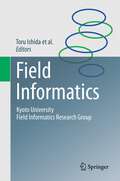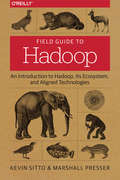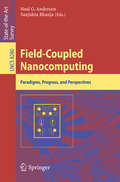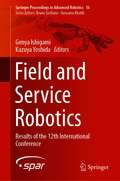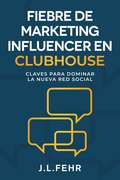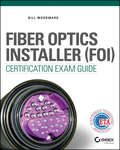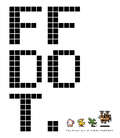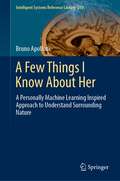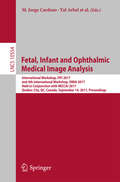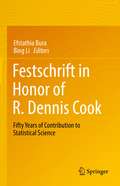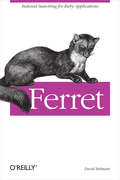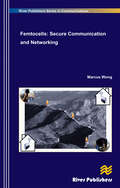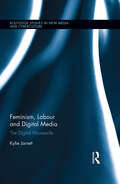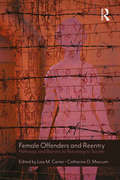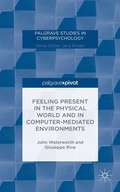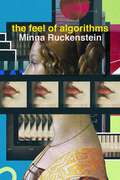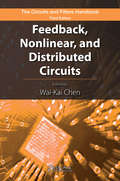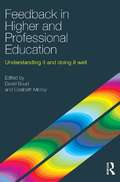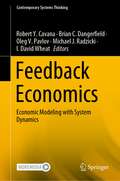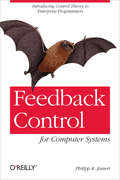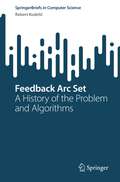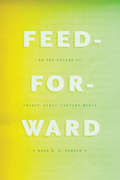- Table View
- List View
Field Trip to the Taiga: The Creeper Diaries, An Unofficial Minecrafters Novel, Book Nine (The Creeper Diaries #9)
by Greyson MannDid someone say “field trip”? Gerald is all in! He’d much rather be exploring the Taiga than sleeping through science class. His buddy Sam is all about spotting polar bears, but Gerald is having way too much fun building igloos and snow golems. His science teacher says there are only two rules—learn something every day, and stay with the group. (That’s adult speak for “don’t get lost.”) When Gerald discovers a secret trapdoor in an igloo, he doesn’t exactly get lost. But . . . if he’s not careful, his classmates might just lose him!
Field Informatics
by Toru IshidaHere we use the term "field" to refer to a sphere of practical operation, and correspondingly the term "field informatics" describes informatics tools and methodologies that arise in the field. The components of field informatics are description, prediction, design and transfer, and the methods for those components vary widely. For example, we consider the social goal of revitalizing a mountainous area experiencing depopulation and we show how the tools and methodologies of field informatics may be used to describe such situations using remote sensing, biologging, human sensing and ethnography; the effects of various solutions can be predicted using system dynamics and multiagent simulations; the solutions can be designed using inclusive design or participatory design methods; and finally the experience gained can be transferred using case writing and outreach communication. The authors are specialists in diverse areas such as informatics, engineering, agriculture, sociology and pedagogy, and their areas of interest range from environment conservation to social education for international cooperation. They have a particular focus on the environment in southeast Asia and related topics such as large-scale traffic simulations, participatory workshops, inclusive design workshops, distance learning, and intercultural collaboration. This book targets graduate students seeking tools and methodologies for natural observation, field workers engaged in social participation, and researchers and engineers pursuing innovation. The techniques described in the book could also be exploited by government officials to form consensus and develop activities or by non-profit organizations to undertake more effective social programs.
Field Guide to Hadoop
by Marshall Presser Kevin SittoIf your organization is about to enter the world of big data, you not only need to decide whether Apache Hadoop is the right platform to use, but also which of its many components are best suited to your task. This field guide makes the exercise manageable by breaking down the Hadoop ecosystem into short, digestible sections. You'll quickly understand how Hadoop's projects, subprojects, and related technologies work together.Each chapter introduces a different topic--such as core technologies or data transfer--and explains why certain components may or may not be useful for particular needs. When it comes to data, Hadoop is a whole new ballgame, but with this handy reference, you'll have a good grasp of the playing field.Topics include:Core technologies--Hadoop Distributed File System (HDFS), MapReduce, YARN, and SparkDatabase and data management--Cassandra, HBase, MongoDB, and HiveSerialization--Avro, JSON, and ParquetManagement and monitoring--Puppet, Chef, Zookeeper, and OozieAnalytic helpers--Pig, Mahout, and MLLibData transfer--Scoop, Flume, distcp, and StormSecurity, access control, auditing--Sentry, Kerberos, and KnoxCloud computing and virtualization--Serengeti, Docker, and Whirr
Field-Coupled Nanocomputing
by Neal G. Anderson Sanjukta BhanjaField-coupled nanocomputing (FCN) paradigms offer fundamentally new approaches to digital information processing that do not utilize transistors or require charge transport. Information transfer and computation are achieved in FCN via local field interactions between nanoscale building blocks that are organized in patterned arrays. Several FCN paradigms are currently under active investigation, including quantum-dot cellular automata (QCA), molecular quantum cellular automata (MQCA), nanomagnetic logic (NML), and atomic quantum cellular automata (AQCA). Each of these paradigms has a number of unique features that make it attractive as a candidate for post-CMOS nanocomputing, and each faces critical challenges to realization. This State-of-the-Art-Survey provides a snapshot of the current developments and novel research directions in the area of FCN. The book is divided into five sections. The first part, Field-Coupled Nanocomputing Paradigms, provides valuable background information and perspectives on the QDCA, MQCA, NML, and AQCA paradigms and their evolution. The second section, Circuits and Architectures, addresses a wide variety of current research on FCN clocking strategies, logic synthesis, circuit design and test, logic-in-memory, hardware security, and architecture. The third section, Modeling and Simulation, considers the theoretical modeling and computer simulation of large FCN circuits, as well as the use of simulations for gleaning physical insight into elementary FCN building blocks. The fourth section, Irreversibility and Dissipation, considers the dissipative consequences of irreversible information loss in FCN circuits, their quantification, and their connection to circuit structure. The fifth section, The Road Ahead: Opportunities and Challenges, includes an edited transcript of the panel discussion that concluded the FCN 13 workshop.
Field-Coupled Nanocomputing: Paradigms, Progress, and Perspectives (Lecture Notes in Computer Science #8280)
by Neal G. Anderson and Sanjukta BhanjaField-coupled nanocomputing (FCN) paradigms offer fundamentally new approaches to digital information processing that do not utilize transistors or require charge transport. Information transfer and computation are achieved in FCN via local field interactions between nanoscale building blocks that are organized in patterned arrays. Several FCN paradigms are currently under active investigation, including quantum-dot cellular automata (QCA), molecular quantum cellular automata (MQCA), nanomagnetic logic (NML), and atomic quantum cellular automata (AQCA). Each of these paradigms has a number of unique features that make it attractive as a candidate for post-CMOS nanocomputing, and each faces critical challenges to realization.This State-of-the-Art-Survey provides a snapshot of the current developments and novel research directions in the area of FCN. The book is divided into five sections. The first part, Field-Coupled Nanocomputing Paradigms, provides valuable background information and perspectives on the QDCA, MQCA, NML, and AQCA paradigms and their evolution. The second section, Circuits and Architectures, addresses a wide variety of current research on FCN clocking strategies, logic synthesis, circuit design and test, logic-in-memory, hardware security, and architecture. The third section, Modeling and Simulation, considers the theoretical modeling and computer simulation of large FCN circuits, as well as the use of simulations for gleaning physical insight into elementary FCN building blocks. The fourth section, Irreversibility and Dissipation, considers the dissipative consequences of irreversible information loss in FCN circuits, their quantification, and their connection to circuit structure. The fifth section, The Road Ahead: Opportunities and Challenges, includes an edited transcript of the panel discussion that concluded the FCN 13 workshop.
Field and Service Robotics: Results of the 12th International Conference (Springer Proceedings in Advanced Robotics #16)
by Genya Ishigami Kazuya YoshidaThis book comprises select proceedings of the 12th Conference on Field and Service Robotics (FSR 2019) focusing on cutting-edge research carried out in different applications of robotics, including agriculture, search and rescue, aerial marine, industrial, and space. It focuses on experiments and demonstrations of robotics applied to complex and dynamic environments and covers diverse applications. The essays are written by leading international experts, making it a valuable resource for researchers and practicing engineers alike.
Fiebre De Marketing Influencer en Clubhouse: Claves Para Dominar La Nueva Red Social
by J. L. FehrLos influencers no son los únicos que están promocionándose en Clubhouse, la red social de audio. Y pese a su popularidad, muchos ni siquiera han oído de ella. Así que, ¿por qué deberías estar allí, y cuál es la mejor forma de aprovecharla? El espacio entre nuestras orejas es uno de los sitios más íntimos que podemos concederle a otras personas, y las voces pueden transmitir una vida entera de experiencias en un instante. El volumen, el registro, el tono, la dicción, y las palabras mismas; todos éstos elementos dejan impresiones indelebles. Clubhouse da lugar a las interacciones entre personas más profundas, cuando se la compara con el resto de las redes sociales. Y aún así, es preciso aprender a usar correctamente la app para convertirla en una poderosa y nóvel herramienta de comunicación. Este libro se escribió para ayudarte a aprender cómo usar esta plataforma, para que puedas promocionarte de la misma forma que lo hacen los influencers más notables.
Fibrous materials
by Krishan K. ChawlaThis new updated edition provides an unrivaled overview of fibrous materials, their processing, microstructure, properties, and applications. The entire range of fibrous materials is discussed in depth, from natural polymeric fibers such as silk and vegetable fibers, and synthetic polymeric fibers such as aramid and polyethylene, to metallic fibers including steel, tungsten, Nb-Ti, and Nb3Sn, ceramic fibers such as alumina and silicon carbide, and carbon and glass fibers. Fundamental concepts are explained clearly and concisely along with detail on applications in areas including medicine, aerospace, optical communications, and recycling. Significant recent advances are also covered, with new information on the electrospinning of fibers, carbon nanotubes, and photonic bandgap fibers, and detail on advances made in the production and control of microstructure in high stiffness and high strength fibers. Accessibly written and unrivaled in scope, this is an ideal resource for students and researchers in materials science, physics, chemistry, and engineering. The only comprehensive introduction to the topic. Fully updated with new information on electrospun fibers, carbon nanotubes, and photonic bandgap fibers. Covers a range of applications in areas including medicine, aerospace, optical communications, and recycling.
Fiber Optics Installer (FOI) Certification Exam Guide
by Bill WoodwardPass the FOI exam with a strong foundation in fiber optic technologyFiber Optics Installer (FOI) Certification Exam Guide gives you a solid foundation in fiber optics and thorough preparation for the Fiber Optics Installer (FOI) certification. Endorsed by the Electronics Technicians Association, International, this guide serves as both a comprehensive self-study course and a useful desk reference for aspiring fiber optics installers. Coverage includes the basic principles of light, optical fiber construction, safety, fusion, mechanical splicing, connectors, fiber-optic light sources, transmitters, detectors, test equipment, and more. Each chapter meets or exceeds the ETA FOI knowledge competency, with key exam information highlighted for easy reference. Real-world scenarios illustrate how particular solutions are applied in common working environments, giving you a clear understanding of to use the tactics in the field. Chapter exercises and review questions offer plenty of opportunity for practice.This book helps you prepare for certification, and more importantly, the everyday work the job entails.Determine how much you already know with a pre-study assessmentFind key exam information and terms quickly with chapter-by-chapter objectivesStudy real-world scenarios to understand how concepts are appliedPinpoint weak areas with practice and review questions that test your knowledgeIf you are seeking a strong knowledge base -- and complete exam prep -- you will find Fiber Optics Installer (FOI) Certification Exam Guide to be a critically useful reference.
FF DOT: The Pixel Art of Final Fantasy
by Square EnixA hardcover volume that showcases the intriguing evolution of pixel art from the Final Fantasy series!Containing detailed sprite sheets that showcase the pixel composition of Final Fantasy's beloved characters, maps of Final Fantasy's most popular highlighting tools used by the developers, and a special interview with Kazuko Shibuya, the character pixel artist for the Final Fantasy series, FF Dot is a one of a kind product that immerses readers into an iconic aspect of the Final Fantasy experience. Dark Horse Books is proud to collaborate with Square Enix to bring fans FF Dot: The Pixel Art of Final Fantasy, translated into English for the first time. This localization of the original Japanese publication holds nearly 300 pages of colorful pixel art, and is an invaluable addition to any Final Fantasy fan's collection.
A Few Things I Know About Her: A Personally Machine Learning Inspired Approach to Understand Surrounding Nature (Intelligent Systems Reference Library #219)
by Bruno ApolloniThis book reconsiders key issues, such as description and explanation, which affect data analytics. For starters: the soul does not exist. Once released from this cumbersome roommate, we are left with complex biological systems: namely, ourselves, who must configure their environment in terms of worlds that are compatible with what they sense. Far from supplying yet another cosmogony, the book provides the cultivated reader with computational tools for describing and understanding data arising from his surroundings, such as climate parameters or stock market trends, even the win/defeat story of his son football team. Besides the superposition of the very many universes considered by quantum mechanics, we aim to manage families of worlds that may have generated those data through the key feature of their compatibility. Starting from a sharp engineering of ourselves in term of pairs consisting of genome plus a neuron ensemble, we toss this feature in different cognitive frameworks within a span of exploitations ranging from probability distributions to the latest implementations of machine learning. From the perspective of human society as an ensemble of the above pairs, the book also provides scientific tools for analyzing the benefits and drawbacks of the modern paradigm of the world as a service.
Fetal, Infant and Ophthalmic Medical Image Analysis: International Workshop, FIFI 2017, and 4th International Workshop, OMIA 2017, Held in Conjunction with MICCAI 2017, Québec City, QC, Canada, September 14, Proceedings (Lecture Notes in Computer Science #10554)
by M. Jorge Cardoso, Tal Arbel, Andrew Melbourne, Hrvoje Bogunovic, Pim Moeskops, Xinjian Chen, Ernst Schwartz, Mona Garvin, Emma Robinson, Emanuele Trucco, Michael Ebner, Yanwu Xu, Antonios Makropoulos, Adrien Desjardin and Tom VercauterenThis book constitutes the refereed joint proceedings of the International Workshop on Fetal and Infant Image Analysis, FIFI 2017, and the 6th International Workshop on Ophthalmic Medical Image Analysis, OMIA 2017, held in conjunction with the 20th International Conference on Medical Imaging and Computer-Assisted Intervention, MICCAI 2017, in Québec City, QC, Canada, in September 2017. The 8 full papers presented at FIFI 2017 and the 20 full papers presented at OMIA 2017 were carefully reviewed and selected. The FIFI papers feature research on advanced image analysis approaches focused on the analysis of growth and development in the fetal, infant and paediatric period. The OMIA papers cover various topics in the field of ophthalmic image analysis.
Festschrift in Honor of R. Dennis Cook: Fifty Years of Contribution to Statistical Science
by Efstathia Bura Bing LiIn honor of professor and renowned statistician R. Dennis Cook, this festschrift explores his influential contributions to an array of statistical disciplines ranging from experimental design and population genetics, to statistical diagnostics and all areas of regression-related inference and analysis. Since the early 1990s, Prof. Cook has led the development of dimension reduction methodology in three distinct but related regression contexts: envelopes, sufficient dimension reduction (SDR), and regression graphics. In particular, he has made fundamental and pioneering contributions to SDR, inventing or co-inventing many popular dimension reduction methods, such as sliced average variance estimation, the minimum discrepancy approach, model-free variable selection, and sufficient dimension reduction subspaces.A prolific researcher and mentor, Prof. Cook is known for his ability to identify research problems in statistics that are both challenging and important, as well as his deep appreciation for the applied side of statistics. This collection of Prof. Cook's collaborators, colleagues, friends, and former students reflects the broad array of his contributions to the research and instructional arenas of statistics.
Ferret
by David BalmainWith the introduction of Ferret, Ruby users now have one of the fastest and most flexible search libraries available. And it's surprisingly easy to use. This book will show you how to quickly get up and running with Ferret. You'll learn how to index different document types such as PDF, Microsoft Word, and HTML, as well as how to deal with foreign languages and different character encodings. Ferret describes the Ferret Query Language in detail along with the object-oriented approach to building queries. You will also be introduced to sorting, filtering, and highlighting your search results, with an explanation of exactly how you need to set up your index to perform these tasks. You will also learn how to optimize a Ferret index for lightning fast indexing and split-second query results.
Femtocells: Secure Communication and Networking (River Publishers Series In Communications Ser.)
by Marcus WongWith Femtocell popularities and deployments on the rise, a number of Femtocell security breach has been reported as a result of pre-standards versions of Femtocells that did not conform to published standards or implemented as a result of lack of understanding of basic security principles. A considerable amount of effort has been devoted, both in industry forums and standards developing organizations, towards creating technical specifications for the architecture, operational, and security of the Femtocells. Security remains on the minds of operators as the traditionally closed operator core network opens up with the Femtocells extending into the homes of users and potential hackers with more and more powerful tools. Technical topics discussed in the book include:• UMTS/LTE Femtocell security and threat analysis;• CDMA Femtocell security;• WiMAX Femtocell security;• LIPA and SIPTO security;• Small Cells;Femtocells: Secure Communication and Networking provides an in-depth analysis and research results on the security design of Femtocells based on UMTS, LTE, CDMA and WiMAX access technologies. Threat analysis, security requirements as well as security mechanisms used to counter the threats and potential attacks are provided in details covering every aspect of Femtocell security. Femtocells: Secure Communication and Networking is ideal for personnel in communication, networking and security industries as well as academic staff and master/research students in network security, computer science, operational research, electrical engineering and telecommunication systems and the Internet.
Feminism, Labour and Digital Media: The Digital Housewife (Routledge Studies in New Media and Cyberculture)
by Kylie JarrettThere is a contradiction at the heart of digital media. We use commercial platforms to express our identity, to build community and to engage politically. At the same time, our status updates, tweets, videos, photographs and music files are free content for these sites. We are also generating an almost endless supply of user data that can be mined, re-purposed and sold to advertisers. As users of the commercial web, we are socially and creatively engaged, but also labourers, exploited by the companies that provide our communication platforms. How do we reconcile these contradictions? Feminism, Labour and Digital Media argues for using the work of Marxist feminist theorists about the role of domestic work in capitalism to explore these competing dynamics of consumer labour. It uses the concept of the Digital Housewife to outline the relationship between the work we do online and the unpaid sphere of social reproduction. It demonstrates how feminist perspectives expand our critique of consumer labour in digital media. In doing so, the Digital Housewife returns feminist inquiry from the margins and places it at the heart of critical digital media analysis.
Female Offenders and Reentry: Pathways and Barriers to Returning to Society
by Lisa M. Carter Catherine D. MarcumOften, research concerning the female offender is scarce. This book adds to the criminological literature on the topic of reentry for women, focusing on the barriers women face as they return to society and adjust to life after incarceration. Each chapter addresses specific issues, challenges, and obstacles affiliated with the hindrance of successful reentry processes associated with female offenders, as well as data-driven empirical studies. While corrections has often misunderstood or overlooked the needs of returning offenders, the shortcomings of the institutions have a greater impact on women than on their male counterparts, particularly regarding the occurrence of social and medical problems, especially those related to mental health and substance abuse. Female Offenders and Reentry helps criminal justice students and practitioners see the full picture when considering the challenges faced by female offenders reintegrating into society.
Feeling Present in the Physical World and in Computer-Mediated Environments
by John Waterworth Giuseppe RivaThis concise volume presents for the first time a coherent and detailed account of why we experience feelings of being present in the physical world and in computer-mediated environments, why we often don't, and why it matters - for design, psychotherapy, tool use and social creativity amongst other practical applications.
The Feel of Algorithms
by Minna RuckensteinWhy do we feel excited, afraid, and frustrated by algorithms?The Feel of Algorithms brings relatable first-person accounts of what it means to experience algorithms emotionally alongside interdisciplinary social science research, to reveal how political and economic processes are felt in the everyday. People’s algorithm stories might fail to separate fact and misconception, and circulate wishful, erroneous, or fearful views of digital technologies. Yet rather than treating algorithmic folklore as evidence of ignorance, this novel book explains why personal anecdotes are an important source of algorithmic knowledge. Minna Ruckenstein argues that we get to know algorithms by feeling their actions and telling stories about them. The Feel of Algorithms shows how taking everyday algorithmic emotions seriously balances the current discussion, which has a tendency to draw conclusions based on celebratory or oppositional responses to imagined future effects. An everyday focus zooms into experiences of pleasure, fear, and irritation, highlighting how political aims and ethical tensions play out in visions, practices, and emotional responses. This book shows that feelings aid in recognizing troubling practices, and also calls for alternatives that are currently ignored or suppressed.
Feedback, Nonlinear, and Distributed Circuits (The Circuits and Filters Handbook, 3rd Edition)
by Wai-Kai ChenUpon its initial publication, the Handbook of Circuits and Filters broke new ground. It quickly became the resource for comprehensive coverage of issues and practical information that can be put to immediate use. Not content to rest on his laurels, editor Wai-kai Chen divided the second edition into volumes, making the information easily accessible and digestible. In the third edition, these volumes have been revised, updated, and expanded so that they continue to provide solid coverage of standard practices and enlightened perspectives on new and emerging techniques. Feedback, Nonlinear, and Distributed Circuits draws together international contributors who discuss feedback amplifier theory and then move on to explore feedback amplifier configurations. They develop Bode’s feedback theory as an example of general feedback theory. The coverage then moves on to the importance of complementing numerical analysis with qualitative analysis to get a global picture of a circuit’s performance. After reviewing a wide range of approximation techniques and circuit design styles for discreet and monolithic circuits, the book presents a comprehensive description of the use of piecewise-linear methods in modeling, analysis, and structural properties of nonlinear circuits highlighting the advantages. It describes the circuit modeling in the frequency domain of uniform MTL based on the Telegrapher’s equations and covers frequency and time domain experimental characterization techniques for uniform and nonuniform multiconductor structures. This volume will undoubtedly take its place as the engineer's first choice in looking for solutions to problems encountered in the analysis and behavior predictions of circuits and filters.
Feedback in Higher and Professional Education: Understanding it and doing it well
by David Boud Elizabeth MolloyLearners complain that they do not get enough feedback, and educators resent that although they put considerable time into generating feedback, students take little notice of it. Both parties agree that it is very important. Feedback in Higher and Professional Education explores what needs to be done to make feedback more effective. It examines the problem of feedback and suggests that there is a lack of clarity and shared meaning about what it is and what constitutes doing it well. It argues that new ways of thinking about feedback are needed. There has been considerable development in research on feedback in recent years, but surprisingly little awareness of what needs to be done to improve it and good ideas are not translated into action. The book provides a multi-disciplinary and international account of the role of feedback in higher and professional education. It challenges three conventional assumptions about feedback in learning: That feedback constitutes one-way flow of information from a knowledgeable person to a less knowledgeable person. That the job of feedback is complete with the imparting of performance-related information. That a generic model of best-practice feedback can be applied to all learners and all learning situations It seeking a new approach to feedback, it proposes that it is necessary to recognise that learners need to be much more actively involved in seeking, generating and using feedback. Rather than it being something they are subjected to, it must be an activity that they drive.
Feedback Economics: Economic Modeling with System Dynamics (Contemporary Systems Thinking)
by Robert Y. Cavana Brian C. Dangerfield Oleg V. Pavlov Michael J. Radzicki I. David WheatThis book approaches economic problems from a systems thinking and feedback perspective. By introducing system dynamics methods (including qualitative and quantitative techniques) and computer simulation models, the respective contributions apply feedback analysis and dynamic simulation modeling to important local, national, and global economics issues and concerns. Topics covered include: an introduction to macro modeling using a system dynamics framework; a system dynamics translation of the Phillips machine; a re-examination of classical economic theories from a feedback perspective; analyses of important social, ecological, and resource issues; the development of a biophysical economics module for global modelling; contributions to monetary and financial economics; analyses of macroeconomic growth, income distribution and alternative theories of well-being; and a re-examination of scenario macro modeling.The contributions also examine the philosophical differences between the economics and system dynamics communities in an effort to bridge existing gaps and compare methods. Many models and other supporting information are provided as online supplementary files. Consequently, the book appeals to students and scholars in economics, as well as to practitioners and policy analysts interested in using systems thinking and system dynamics modeling to understand and improve economic systems around the world."Clearly, there is much space for more collaboration between the advocates of post-Keynesian economics and system dynamics! More generally, I would like to recommend this book to all scholars and practitioners interested in exploring the interface and synergies between economics, system dynamics, and feedback thinking." Comments in the Foreword by Marc Lavoie, Emeritus Professor, University of Ottawa and University of Sorbonne Paris Nord
Feedback Control for Computer Systems
by Philipp K. JanertHow can you take advantage of feedback control for enterprise programming? With this book, author Philipp K. Janert demonstrates how the same principles that govern cruise control in your car also apply to data center management and other enterprise systems. Through case studies and hands-on simulations, you'll learn methods to solve several control issues, including mechanisms to spin up more servers automatically when web traffic spikes. Feedback is ideal for controlling large, complex systems, but its use in software engineering raises unique issues. This book provides basic theory and lots of practical advice for programmers with no previous background in feedback control. Learn feedback concepts and controller design Get practical techniques for implementing and tuning controllers Use feedback "design patterns" for common control scenarios Maintain a cache's "hit rate" by automatically adjusting its size Respond to web traffic by scaling server instances automatically Explore ways to use feedback principles with queueing systems Learn how to control memory consumption in a game engine Take a deep dive into feedback control theory
Feedback Arc Set: A History of the Problem and Algorithms (SpringerBriefs in Computer Science)
by Robert KudelićThe main aim of the book is to give a review of all relevant information regarding a well-known and important problem of Feedback Arc Set (FAS). This review naturally also includes a history of the problem, as well as specific algorithms. To this point such a work does not exist: There are sources where one can find incomplete and perhaps untrustworthy information. With this book, information about FAS can be found easily in one place: formulation, description, theoretical background, applications, algorithms etc. Such a compendium will be of help to people involved in research, but also to people that want to quickly acquaint themselves with the problem and need reliable information. Thus research, professional work and learning can proceed in a more streamlined and faster way.
Feed-Forward: On the Future of Twenty-First-Century Media
by Mark B. N. HansenEven as media in myriad forms increasingly saturate our lives, we nonetheless tend to describe our relationship to it in terms from the twentieth century: we are consumers of media, choosing to engage with it. In Feed-Forward, Mark B. N. Hansen shows just how outmoded that way of thinking is: media is no longer separate from us but has become an inescapable part of our very experience of the world. Drawing on the speculative empiricism of philosopher Alfred North Whitehead, Hansen reveals how new media call into play elements of sensibility that greatly affect human selfhood without in any way belonging to the human. From social media to data-mining to new sensor technologies, media in the twenty-first century work largely outside the realm of perceptual consciousness, yet at the same time inflect our every sensation. Understanding that paradox, Hansen shows, offers us a chance to put forward a radically new vision of human becoming, one that enables us to reground the human in a non-anthropocentric view of the world and our experience in it.

